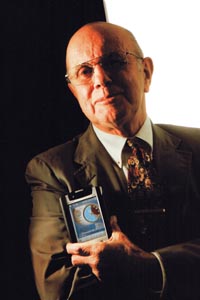 Although we “gain” an hour when we fall back on Nov. 7, the end of daylight saving marks four months of elusive sunlight. But one local business has found a way to help us maximize sunlit time.
Although we “gain” an hour when we fall back on Nov. 7, the end of daylight saving marks four months of elusive sunlight. But one local business has found a way to help us maximize sunlit time.
The Ann Arbor-based Skyclock Co. has developed the first analog clock that, in addition to telling time, shows hours of daylight, nighttime, and twilight. Skyclock’s intent is that people use this extra information to better plan their time.
John Rosevear, president and CEO of the company founded in 1986, began developing the idea for Skyclock because, as a former house painter, he says he “was always curious about the amount of time I could spend [painting outside].” He began collecting recorded times of sunrises and sunsets from the U.S. Naval Observatory and used that information to draw a revamped analog clock with his findings.
Between his extensive research and long-held interest in the passage of time, Rosevear developed the first Skyclock 25 years ago. Originally designed for computers, the clock became available this year as a free iPhone app that uses GPS technology and cell-towers to determine one’s location. Using two algorithms (one developed by a U-M astronomer specifically for Skyclock), it gives down-to-the-minute times for sunrise, sunset, and each period of twilight for every day of the year.
“The pragmatic applications are [that] this adds another hour to your daylight time,” Rosevear says. “We show you that you can spend more time out of doors, in relative safety, every day after the sun sets and before the sun rises.”
This is based on “usable twilight.” For those who aren’t horologe experts, there are three twilight stages based on the sun’s degrees below the horizon: civil, during which you can still see clearly; nautical, during which the first stars appear; and astronomical, during which it’s dark to the naked eye.
Those less interested in the specifics of this twilight trilogy can check the orange segment of the color-coded Skyclock to determine when they can take advantage of natural light before the sun rises and after it sets.
“It enables you to get a little more control over your life,” Rosevear says. “It’s no longer a guessing game.”
|
|
|









